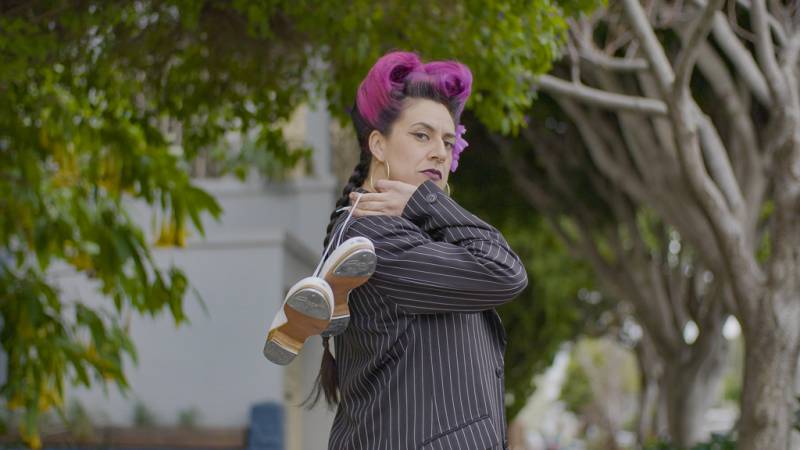Editor’s note: KQED Arts’ award-winning video series If Cities Could Dance is back for a third season! In each episode, meet dancers across the country representing their city’s signature moves. New episodes premiere every two weeks.
In the heart of the Mission, the pulsing beat of the neighborhood’s dense and vibrant mix of Latinx cultures comes from the clicking heels and toes of tap shoes.
San Francisco’s La Mezcla dance company, founded and led by Vanessa Sanchez, uses dance and song to tell stories of Chicana history, culture and resistance. Blending tap dance and zapateado (rhythmic footwork from Mexico), Sanchez describes La Mezcla’s unique dance style as “zapatap.”

“Tap was one of those styles that just made sense to me,” Sanchez explains. “I was always a bit of an outsider and this speaks to why I do what I do now, because a lot of dance training and dance schools don’t necessarily fit dancers of color who are coming into the space.”
Zapatap draws on the history of tap as a form of African American resistance; on the Afro-Mexican dance and music tradition of son jarocho; and, in La Mezcla’s most recent show, Pachuquísmo, on the story of zoot-suited Chicanas in 1940s Los Angeles.
Tap dance originated in the United States in the early 19th century, at the crossroads of African and Irish-American dance forms. When slave owners took away traditional African drums, enslaved people took to percussive dancing to express themselves and maintain their cultural identities. Metal taps hit the market in 1910, and the dance form quickly became a mainstay of Broadway. (Fun fact: May 25 marks National Tap Day, the birthday of early tap dance star Bill “Bojangles” Robinson.)
Son jarocho was born a world away from tap, but also has its roots in a time of oppression and resistance. Developed in Veracruz, Mexico, its sounds are a blend of African, indigenous and Spanish influences, owing to the city’s history as a colonial port and a hub of the transatlantic slave trade. Musician Andres Huesca brought son jarocho to Los Angeles in the 1940s; in wider American pop culture, the most recognizable variation is likely Richie Valens’ 1958 hit “La Bamba.” Central to the musical form is the fandango, a gathering where dancers trade off center stage on the tarima (a wooden platform), to contribute the beat to long-form jams called sones.
Sanchez absorbed this style of dance while living in Veracruz in the early 2010s, trading tap moves for zapateado rhythms. And when it came time to choreograph La Mezcla’s 2019 show about Chicana women who stood up to the racist attacks of the 1943 Zoot Suit Riots, this hybrid style—neither fully Mexican nor fully American—made perfect sense.
“I just feel like throughout history there’s these women that rise up and fight,” Sanchez says. “They fight for what is right, and fight against oppression, systemic racism and white supremacy. But their stories are often not told in the same way as their male counterparts.”
For her and other dancers in the group, embodying the spirit of those women is exhilarating. “When I put on the zoot suit, it’s like—I’m getting chills just talking about it,” Sandy Vazquez says. “It’s a really emotional experience for me continuing the legacy of resistance and survival that these women had to overcome, and then being able to put that on a stage.” Dressed in roomy trousers, their hair piled high on their heads, the women of La Mezcla claim the streets and the stage, proving tap isn’t reserved for Broadway shows.
The percussive dance of zapatap is fierce; it demands attention in the moment and recognition for the people who informed its making. As they witness the Latinx residents of the Mission struggle with displacement and gentrification, La Mezcla uses zapatap as a way to claim not just the physical space they dance upon, but everywhere within earshot of their clicking, stomping feet.
Watch Vanessa Sanchez, Sandy Vazquez, Emmeline Gonzalez-Beban, and Kirsten Millan tour us along Calle 24, the Mission’s cultural corridor, and dance before some of the neighborhood’s most recognizable sights: atop Bernal Hill; in front of the Carnaval mural over the House of Brakes; and at Casa Bandido, musician Richard Segovia’s house covered in paintings by Precita Eyes Muralists depicting the birth and evolution of Latin Rock in the Mission. — Text by Sarah Hotchkiss
Explore our virtual story map and learn more about the murals and locations featured in this episode of If Cities Could Dance.

